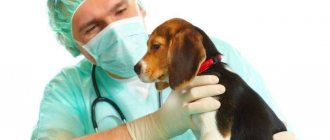How long does it take for a cat to recover from anesthesia?
The operation is performed in a clinic or at home. The animal's behavior seems strange in the first 5 or 6 hours after anesthesia. You can't leave him alone. At this time, the anesthetic effect ends and the animal’s postoperative sutures begin to hurt.
Urinary incontinence occurs, but this phenomenon is temporary and passes quickly. The pet's behavior returns to normal within one or two days. The exact time of residual effect of narcotic substances depends on the type of anesthesia, age and other individual characteristics of the animal. During this period, the pet needs the care of the owner.
Using anesthesia for cats
Caring owners are interested not only in how long it takes for cats to recover from anesthesia after sterilization, but also in the possible danger of the event. Unpleasant consequences can be avoided only if all contraindications are strictly observed.
The drugs used in animal anesthesiology have a mild and safe effect. All dosages are selected individually based on the analysis of the mustachioed patient. Before surgery, the veterinarian must check the functioning of the heart to assess possible risks.
Please note that there is always a possibility of death. A doctor’s denial of this fact is a lie that leaves an imprint on his competence. The main task of the anesthesiologist and veterinary therapist is to minimize risks. By taking into account contraindications and choosing the right drug and dose, the likelihood of complications is close to zero.
After anesthesia, the cat’s body is greatly weakened, so additional aggravating factors are detrimental to it. Contraindications for surgical intervention include:
diseases of the respiratory system and heart;
periods of estrus, gestation and feeding of offspring;
age more than 10 years;
pathologies of the genitourinary system in chronic form and viral infections in acute form.
Despite these limitations, they can be neglected. This is acceptable if the animal’s life is at risk and other methods of treatment do not help it - then the risk of surgery fades into the background.
Veterinarians do not recommend using anesthesia more than once a year - if time is of the essence, it is better to postpone the operation or use alternative treatment methods.
How cats recover from anesthesia after castration - features of the condition
The process of recovery from anesthesia is individual. Some pets behave aggressively, others wake up slowly and remain lethargic for a long time. An inexperienced pet owner runs the risk of being bitten or scratched.
The side effect of drugs is prolonged disorientation in space and impaired coordination of movements. To prevent the consequences of physical activity, the cat is placed in a place from which it cannot fall. The best option is to leave it in a carrier for a while, in a warm, dry place without drafts and away from heating radiators.
Be sure to read:
A sterilized cat asks for a cat: reasons, when it is the norm, what to do, how to avoid
What needs to be done before surgery?
Toilet
Usually, after surgery, a cat is given an anesthetic in the form of an injection directly at the veterinary clinic. Some veterinarians are of the opinion that this is not necessary, but the cat is clearly in pain after surgery, and I would like to somehow alleviate her suffering.
Owners of purring cats should remember that under no circumstances should they use human medications that can harm the animal.
It is advisable that the cat owner have the opportunity, in the event of an unforeseen situation, to contact the doctor and agree with him on a plan of action, discuss the condition of the pet if it raises any concerns or any difficulties are observed.
To alleviate the condition of the operated cat, it is necessary to prepare in advance. It is necessary to place the bedding in a warm place on the floor to avoid falling from elevated positions. It is necessary to isolate the room from drafts.
We suggest you read: Ways to effectively remove fleas from a cat at home
The animal must be taken to surgery in a carrier, on the bottom of which a warm blanket or towel must first be laid. When the cat begins to recover from anesthesia, it will begin to feel very cold. The animal will feel better on a warm blanket.
How to behave when a cat recovers from anesthesia, what to do?
The first three days of the pet should not be lost sight of. You need to monitor the healing process and do not let the cat lick the wound. Otherwise, infection and purulent inflammation are possible. To prevent licking, wear an Elizabethan collar. The seams are treated with products recommended by the veterinarian. If the cat quickly came to his senses, the wounds do not bother him, and they should not be treated again.
Clean water should be nearby at all times. If the animal wants to drink, but cannot do it, you need to wet the mouth with a syringe or pipette, but do not inject it forcibly. You cannot feed your pet on the first day.
An empty tray without filler is placed next to the convalescent person so that the animal does not clog the wound. The toilet should be cleaned daily, or even better after each visit. If the first bowel movements do not occur in the tray, there is no need to punish. It may be painful for a cat to climb. When the condition returns to normal, the habit of going to the toilet will be restored.
If a cat is soiled with urine, it should not be bathed. You should use refreshing wipes.
The first signs of awakening
The first hours after anesthesia, the cat remains in the hospital. At this time, doctors monitor their cardiac activity to exclude complications and promptly provide first aid if necessary.
The pet is handed over to the owner only after complete awakening. In the first day you will have to constantly look after him, since, in addition to drowsiness, there is a lack of coordination.
After returning to normal conditions, the animal will try to get up to walk around the room. Moving paws will shake confidence in safety. A frightened cat may become aggressive. You should not try to help her if the actions taken do not threaten her safety.
Over time, aggressive behavior gives way to apathy. The animal crashes into the walls, falls out of the blue and has difficulty holding its head up. In this state, he really needs the moral support of his owner. Talk to him in a soft voice and stroke him to relieve any fear and tension that has arisen.
During abdominal operations, a special blanket is put on the animal. This prevents him from licking the wound and protects him from the seams coming apart. Sometimes a special cone collar serves this purpose.
The anesthetic lowers body temperature and prevents free blinking. At first, the cat will be cold and will not be able to close its eyes. Every half hour she will have to instill eye drops to protect her mucous membranes from drying out.
Set up a comfortable and warm place on the floor, covering it with a disposable diaper - the animal may wet itself. Make sure your pet doesn't jump. Due to poor coordination, she may fall and get hurt. In case of severe weakness, it is better to place your pet on the right side. This will make the heart work easier.
When protecting your cat from the cold, do not go to extremes. Using a heating pad and heating devices is fraught with the development of an inflammatory process. If your pet is trembling, cover it with a blanket. Try to keep children and other pets away from it. In a calm environment, the cat's behavior will be more appropriate.
In case of prolonged apathy and lack of physical activity, check the reaction to stimuli:
Open your pet's eyelids. When exposed to sunlight or artificial light, the pupils should contract.
Blow gently into your ear. Feeling the flow of air, the pet should move its ear.
Make a clap over the animal's head. It should flinch in surprise.
If the reaction is positive, then just be patient. You should consult a doctor only if your pet does not respond to any of the stimuli.
Cat after anesthesia: 6 signs that should alert the owner
A conscientious owner takes a vacation while caring for a neutered cat. Despite the simplicity of the operation, your pet may experience complications for a number of reasons.
The following are symptoms that may require veterinary attention:
- Low or high body temperature. The norm for cats is from 37.5 to 39.0 °C. The veterinary surgeon who performed the operation will tell you how often you need to measure your temperature. The problem is that anal measurement is painful. Therefore, purchase an ear or non-contact thermometer. The costs will pay off, since the need for thermometry will arise more than once during your life.
- Refusal to drink for a day and food for more than three days. If the cat does not drink, the concentration of salts in the urine will increase, which can lead to sedimentation and the onset of urolithiasis. Some cats may go 3 or more days without drinking when fed wet, prepared, canned food or natural food. But after the operation, a day is considered an acceptable period. Perhaps refusal to drink indicates intoxication, in which vomiting occurs when food or water enters the stomach. A healthy cat can go without food for 5 days. But, for the speedy healing of wounds, the operated pet needs nutrients. On the second day, a third of the feed is given from the norm, and at the end of the week the consumption is brought up to the recommended value.
- Stiffness in movements due to a feeling of interference in the perineum. This may be due to swelling of the sutures, but it is dangerous to act at your own risk.
- Pain when stroking the abdomen. Probably, the infection entered the abdominal cavity during the operation, or after it with a sudden movement, peritonitis develops
- Painful and difficult urination , accompanied by a plaintive meow.
- Dehiscence of the suture, bleeding for 2-3 days or the appearance of purulent discharge.
Be sure to read:
How to care for a cat after sterilization: blanket, diet, treatment and removal of sutures
The effect of anesthesia on the animal's body
Drugs that put a mustachioed patient into artificial sleep have a depressing effect on the brain’s cortical centers. They minimize sensitivity, but at the same time destroy nerve fibers and negatively affect the functioning of the cardiovascular system. The result of exposure to toxins is often hallucinations, blurred vision or hearing, headaches, and sleep destabilization.
We recommend this article:
Why castrate a cat: pros and cons of the operation
As a rule, such effects disappear 2-4 hours after surgery. If an animal is diagnosed with a cardiac disorder, anesthesia often causes arrhythmia, which can last up to 2-3 days.
Veterinarians use not too strong substances to induce anesthesia.
Typically, veterinarians use a gentle anesthesia to remove the testes, which is different from traditional general anesthesia. It begins to act 10-30 minutes after administration. The dose is calculated based on the medical history. Dosage is also affected by body weight and age. A side effect of using the medicine may be vomiting, but this is a normal reaction of the body to toxins, and therefore you should not be afraid.
We recommend this article:
At what age are cats sterilized: recommendations from veterinarians
How long can a cat have a fever after castration?
After castration, as after any surgical intervention, it is necessary to monitor body temperature. In the first hours it may drop below 37 °C. This is explained by stress, blood loss, and slowing of metabolism under the influence of anesthesia. The cat may shiver, so it should be well wrapped.
The advice to cover your pet with heating pads is questionable, as it promotes bleeding. The temperature should return to normal within 24 hours. If hypothermia continues for the second day, you should inform your veterinarian.
But, on the first day the temperature can rise to 40 °C. If no other pathological symptoms are noticed, there is no need to worry. But when a pet has a fever 4 or more days after surgery, veterinary care is necessary: an inflammatory process develops. You should not give your cat antipyretic medications, since their effect on humans and cats is different.
How to prepare an animal for surgery
Most complications that appear in the postoperative period are associated with a sharp drop in immunity. To preserve the body's defenses, it is important to prevent any pathological conditions that could harm the pet.
Most often, operated patients become infected with worms and viruses, so treatment against parasites and vaccination are prerequisites for operations under general anesthesia. An anthelmintic is given 1.5 weeks before the procedure, and the vaccine is administered no later than a month.
If vaccination is missed according to schedule, then a serum injection is used. It gives similar results in a shorter time - within 2 weeks.
A couple of days before the operation, the blood and urine of the future patient are checked for possible deviations. To calculate the volume of anesthesia, indicators obtained on ultrasound and x-ray of the respiratory and cardiac organs are taken into account.
Half a day before the start of the operation, the cat should not be fed, and 3 hours before the operation, the cat should not be given water. The absence of solid and liquid food prevents the occurrence of nausea, which can lead to pneumonia due to aspiration of vomit.
First hours
After the administration of anesthesia, the first day is considered critical. At this time, it is necessary to constantly be near the animal and observe its condition.
After coming home, the cat should be placed in a soft and warm place. Make sure that your pet is not exposed to drafts, and also isolate the “bed” from other animals in the house. Keep children away from the cat's resting place.
You can't put a cat on a hill. When he wakes up from anesthesia, he will not have full control of his movements and may fall. Therefore, the bed needs to be arranged on the floor. Place an oilcloth under the bed, as the cat will not be able to control its needs at first. And periodically you will need to clean up after it.
The cat should be laid down so that the stitches after the operation are in the most relaxed position. The cat should not pull or rub anything.
After abdominal surgery, your cat will need to wear a blanket. This will protect the stitches from contamination and keep them safe when the animal wakes up and tries to examine the scar.











